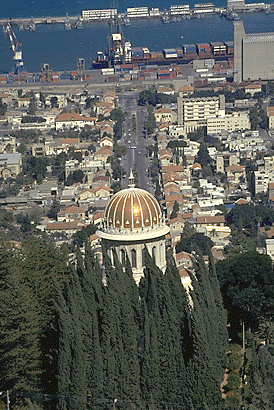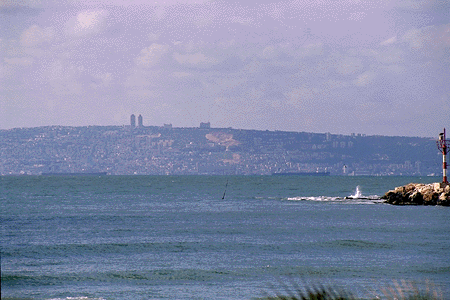
View of Haifa and harbor from above the Shrine of the Báb

The Bahá'í Faith assumes a priori that religious revelation is not final but progressive, and that Judaism, Christianity, and Islam are all divine in origin.[01] Referring to the various world religions, Bahá'u'lláh (1817-1892), the prophet-founder of the Bahá'í Faith, wrote,
These principles and laws, these firmly-established and mighty systems, have proceeded from one Source, and are the rays of one Light. That they differ one from another is to be attributed to the varying requirements of the ages in which they were promulgated.[02]
The Holy Land of the Jews, Christians, and Muslims thus retains its significance and sacredness to the Bahá'ís. The Bahá'ís uphold the Torah, the New Testament, and the Quran as divinely inspired, and the fact that many of the historical figures mentioned in these great religious books actually lived and walked on the Holy Land is, by itself, sufficient reason for many Bahá'ís to revere the Holy Land. It has even been speculated that the Holy Land may bear some indirect relationship to other religions.[03]
But the Holy Land's significance to the Bahá'ís is not just a result of the Holy Land's association with previous religions. The Holy Land has a historical link to the Bahá'í Faith. The historical association is possibly the primary reason behind the great importance which Bahá'ís attach to the Holy Land.
Bahá'u'lláh's prophetic mission began in Persia in 1852 and he formally founded the Bahá'í Faith in 1863. He revealed many prayers, spiritual teachings, and social principles. Examples of his spiritual teachings include the oneness of God, the oneness of religion, and the oneness of mankind. Examples of his social teachings include universal education, world government, the abolishment of clergy, the abandonment of all forms of prejudice, the adoption of an auxiliary international language, and equal rights for men and women. Many of Bahá'u'lláh's ideas were too radical for the society in which he lived. The history of the persecution of the Bahá'í Faith dates back to the days of Bahá'u'lláh. From Persia he was exiled consecutively to Baghdad, to Constantinople, to Adrianople, and finally to the Holy Land.[04]

Moreover, the spiritual capital of the Bahá'í Faith is also in the Holy Land. To the Bahá'í, the holiest spot on earth is the resting place of Bahá'u'lláh's mortal remains: the Shrine of Bahá'u'lláh at Bahjí, north of `Akká. Bahá'ís, when reciting their prayers, turn towards the Shrine of Bahá'u'lláh in the same way that Muslims turn to the Kaaba in Mecca. The Shrine of Bahá'u'lláh is the qiblih of the Bahá'í world.[07]
Evidence exists for the two-fold origin of the Holy Land's sacredness to Bahá'ís. The description of the Holy Land by Shoghi Effendi given below shows that the Holy Land's significance to the Bahá'ís has its origin both in Bahá'í belief in the divine origin of older religions, and in early Bahá'í history. Shoghi Effendi describes this region of the earth as
...the Holy Land-the Land promised by God to Abraham, sanctified by the Revelation of Moses, honoured by the lives and labours of the Hebrew patriarchs, judges, kings, and prophets, revered as the cradle of Christianity, and as the place where Zoroaster, according to `Abdu'l-Bahá's testimony, had ``held converse with some of the prophets of Israel,'' and associated by Islám with the Apostle's night-journey, through the seven heavens, to the throne of the Almighty. Within the confines of this holy and enviable country, ``the nest of all the prophets of God,'' ``the Vale of God's unsearchable Decree, the snow-white Spot, the Land of unfading splendor'' was the Exile of Baghdád, of Constantinople and Adrianople condemned to spend no less than a third of the allotted span of His life, and over half of the total period of His Mission. ``It is difficult,'' declares `Abdu'l-Bahá, ``to understand how Bahá'u'lláh could have been obliged to leave Persia, and to pitch His tent in this Holy Land, but for the persecution of His enemies, His banishment and exile.''[08]
The Bahá'í pilgrim to the Holy Land is thus brought into contact with the sacred sites of four successive divine dispensations: Judaism, Christianity, Islam, and the Bahá'í Faith. As David Ruhe, former member of the Universal House of Justice, explains,
A pilgrimage to Israel constitutes a journey in progressive Revelation, an experience confirming the reality of the concept of evolution in religion.[09]